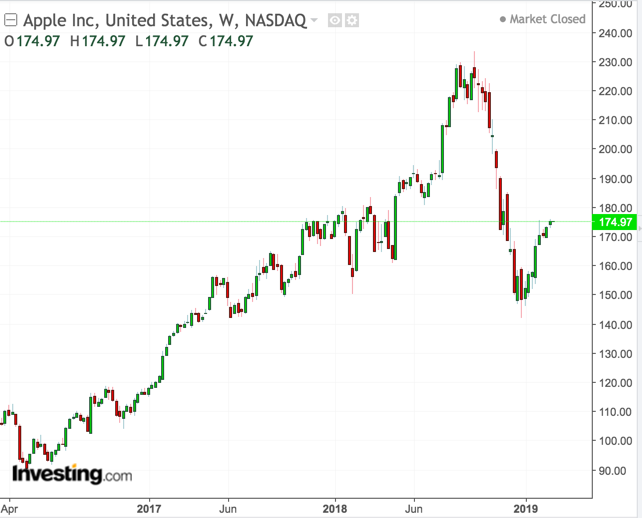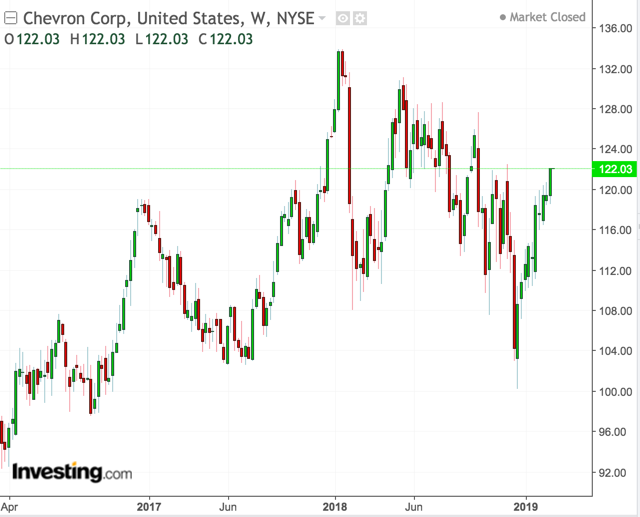For those investing in equities in order to increase savings, the big challenge is to pick the stocks that not only preserve capital, but also offer a decent return. While some investors chase higher yields, ignoring the risk that comes with them, a simple way to gradually boost savings is to look for companies that raise their dividends and are positioned to maintain that practice.
By buying solid dividend-growth stocks, you pick companies with good financial health that enables them to outperform other areas of the market. According to a research by Goldman Sachs’ wealth management division, companies that consistently grew their payouts produced 14-fold better returns than non-dividend-paying companies between 1972 and 2014.
With that theme in the backdrop, below are two examples of great dividend-growth stocks:
1. Apple
Apple Inc. (NASDAQ:AAPL) is generally considered a high-growth technology stock that one buys to earn quick returns. That view isn’t entirely wrong, given Apple’s massive innovation machine that continues to produce fast-selling consumer products, such as iPhones and Apple Watch. The shares have grown almost 700% since they were first sold at $22 apiece in December 1980, and about 66% in the last three years. They closed up 1.1% at $174.97 on Friday.

But, in our view, Apple is also a great candidate for your long-term income portfolio. As the company enters a mature stage of its growth cycle, it’s getting ready to return more and more cash to investors through its dividends and share buybacks.
After boosting its dividend by 16% in 2018, Apple now pays $0.73 a share quarterly, which has been growing more than 10% per year during the past five years. The company has been hiking its payouts for the past seven years, and there is no sign that the maker of iPhones will stop this practice. With a payout ratio of just 24% and a massive cash-hoard, Apple is in a good position to return capital.
Even If you take into account the bear case against Apple, which assumes it has seen the best days of its flagship iPhone sales, Apple’s ability to generate cash for its shareholders remains intact. The company is expected to generate $255 billion in sales in the current year, with an estimated 13% growth per year during the next five years, according to analysts’ consensus forecast.
2. Chevron
If you focus solely on the volatile nature of energy markets, it’s hard to find value in integrated U.S. oil companies. But after years of cost-cutting, technological advances, and rationalized investment approaches, some global oil and gas producers are offering an excellent entry point to income investors. And U.S. oil super-major, Chevron (NYSE:CVX) is certainly one of them.
Since October 2001, shares have been boosted 174%, growing almost 29% in the past three years alone. They rose 2.1% on Friday to close at $122.03.

The second-largest global oil producer, Chevron runs integrated operations with both upstream and downstream exposure as well as a separate petrochemical division. This diversified business model offers a great hedge against falling oil prices.
Even if the company loses money on oil and gas production, its energy product refining and commodity petrochemical businesses can still generate cash, mitigating the impact of an oil market slump. The evidence of this strength came in the fourth quarter of last year, when Chevron beat expectations on earnings, producing strong cash flows in the period despite Brent crude oil’s 38% plunge.
And when it comes to dividends, Chevron has been reliable, generating higher income each year. During the past 10 years, its quarterly payout, now at $1.19 per share, has grown about 8% a year. We believe that rate of growth will accelerate going forward, helped by the company’s improving cash flows.
Chevron’s free cash flow once dividends are paid touched $8.3 billion in 2018, after remaining in the negative territory for the previous five years as these big oil companies rode through the oil downturn that started in 2014, according to Bloomberg data.
But with a reasonable payout ratio of 58 and quite attractive dividend yield of 3.9%, we believe Chevron is now ripe to begin growing income once again. With the increasing dividends, you will also benefit from the company’s aggressive $25-billion share buyback plan.
Bottom Line
Investing in companies with solid cash-flow streams and low payout ratios is a proven way to gradually improve your return on savings. There is definitely higher risk in investing in stocks, but you mitigate that risk by investing in dividend stocks.
Both Apple and Chevron are good examples of such equities. Power and gas utilities, telecom operators, and real estate investment trusts are other areas that offer regular income that you can explore to diversify your portfolio.
